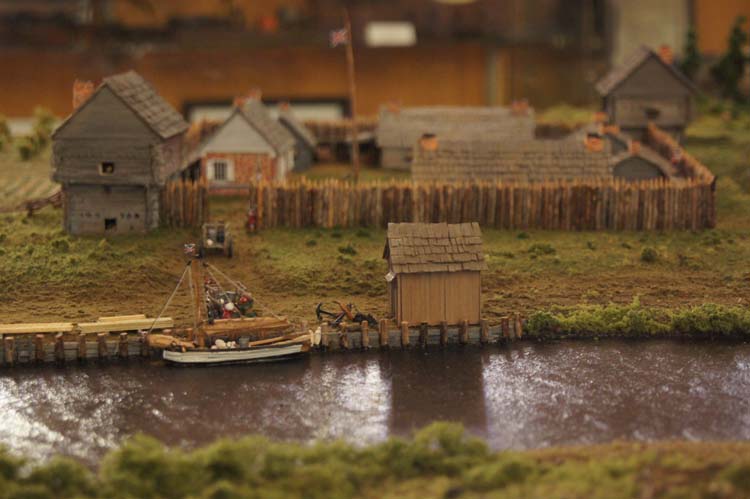
The St. Clair Inn, a captivating architectural gem nestled along the scenic banks of the St. Clair River in Michigan, has a rich and vibrant history deeply intertwined with the evolution of the surrounding community. Constructed in 1926, the Inn has borne witness to periods of economic prosperity, decline, and ultimately, remarkable renewal, with each era leaving an indelible mark on its distinctive character and charm. This comprehensive analysis delves into the fascinating past of the St. Clair Inn, exploring its origins, architectural significance, the evolution of its ownership and management, and its enduring legacy as a beloved landmark.
Origins and Construction
In the early 20th century, the St. Clair River was a bustling hub of activity, with passenger steamers and recreational boats plying its waters. Recognizing the need for a luxurious establishment to accommodate the burgeoning tourism industry and serve as a social center for the community, the St. Clair Rotary Club spearheaded the initiative to build a grand hotel in 1925 . Leading businessmen of the area joined forces to form the St. Clair Community Hotel Corporation, enlisting the expertise of Hockenbury System, Inc. of Harrisburg, Pennsylvania, to advise on financing the ambitious venture . The financial plan they developed was modeled after successful community hotel campaigns in over one hundred cities across the nation, ensuring a solid foundation for the project .
The public offering of stock for the hotel began in July 1925, and the community’s response was overwhelmingly positive. Within ten days, the campaign surpassed its ambitious goal of $180,000, a testament to the community’s enthusiasm and belief in the project . With the necessary funds secured, the St. Clair Community Hotel Corporation entrusted the design of the Inn to the renowned Port Huron architect Walter H. Wyeth, with F.R. Patterson also contributing to the architectural vision .
Drawing inspiration from the picturesque English country inns, Wyeth envisioned a structure that exuded old-world charm and elegance. The Inn was designed in the Neo-Tudor style, a popular architectural choice in the 1920s that evoked a sense of history and grandeur . Construction was completed in September 1926, and the St. Clair Inn opened its doors with sixty well-appointed guest rooms .
The Inn’s architectural details were carefully considered to create a welcoming and visually appealing atmosphere. The exterior featured a combination of English brick and half-timbered plaster walls, creating a distinctive Tudor Revival aesthetic . A whimsical round tower added a touch of fantasy to the façade, while eyebrow windows on the riverside of the building provided unique views of the St. Clair River . The Inn’s U-shaped design created a courtyard on the street side, enhancing the sense of intimacy and privacy .
Stepping inside the Inn, guests were greeted by a grand lobby with a brick floor and a heavily beamed ceiling, showcasing exposed rough-hewn timbers that added a rustic yet refined touch . A grayed oak staircase led to the second floor, while the nearby lounge provided a cozy retreat with two fireplaces: one constructed of English brick with an oak mantel and the other of limestone, featuring medieval-themed insets that added a touch of historical flair . The main dining room, originally an open porch, was later enclosed to provide a more formal dining experience . Notably, the St. Clair Inn holds the distinction of being the first hotel in the United States to offer the modern comfort of central air conditioning, a testament to its commitment to providing guests with a luxurious experience .
Ownership and Management
The St. Clair Inn’s journey through time has been marked by changes in ownership and management, each contributing to its unique story. Following the economic turmoil of the Great Depression, the Inn faced financial hardship and went into receivership in 1932 . After a period of uncertainty, the St. Clair Hotel Corporation regained control of the property in 1943 and appointed Creighton W. Holden, a prominent local restaurateur, as the Inn’s manager . Holden’s astute management and dedication to the Inn’s success proved to be a turning point in its history.
Recognizing the Inn’s potential, Holden demanded and received majority ownership in the St. Clair Hotel Corporation, and by 1948, he and his sons, Creighton Jr. and Robert, had acquired the entire corporation, transforming the St. Clair Inn into a privately held family business . The Holden family’s ownership marked an era of prosperity and growth for the Inn. They invested in improvements, expanding the facilities and enhancing its appeal to a wider range of guests . Among their notable contributions were the addition of a swimming pool, a pro shop, and a renovated clubhouse, transforming the Inn into a sought-after destination for leisure travelers, families, and business professionals alike . The Holdens’ commitment to excellence and their deep connection to the community solidified the Inn’s reputation as a cherished local landmark. They retained ownership until 1975, leaving an enduring legacy of hospitality and community engagement .
Significant Events and Personalities
Throughout its history, the St. Clair Inn has been associated with a number of significant events and has played host to notable personalities, adding to its allure and mystique. During the Prohibition era, Creighton Holden Sr. faced a daunting challenge when members of the notorious Purple Gang approached him with demands . They insisted that he pay them protection money and allow them to use the Inn’s basement as a storage and drop-off point for bootlegged liquor being smuggled in from Canada . Refusing to compromise his principles and the Inn’s reputation, Holden stood his ground, defying the gangsters’ threats. Instead, he offered the gang leader hospitality as a guest at the Inn and pledged to continue supporting any legitimate businesses operated by members of the Purple Gang family . Impressed by Holden’s courage and integrity, the gang leader accepted his offer, and the St. Clair Inn remained free from any further interference from the Purple Gang or other mobsters.
The Inn’s guest list over the years has included prominent figures from various walks of life, including the infamous labor leader Jimmy Hoffa, whose presence added to the Inn’s mystique and fueled local legends . In the world of sports, the Inn welcomed Wiffi Smith, a rising star in women’s golf, who stayed at the Inn in 1955 while practicing at the St. Clair Golf Club . Smith, who had won the USGA National Juniors in 1954 and the Woman’s Amateur North/South title in 1955, used the Inn as her base while honing her skills on the golf course . She turned pro in 1957 and went on to win eight LPGA Tour titles between 1957 and 1960, with fond memories of her time at the St. Clair Inn and the hospitality of the Holden family . The Inn’s association with such accomplished individuals further enhanced its reputation as a destination for both relaxation and recreation.
The St. Clair Inn also holds the distinction of having hosted 12 weddings in a single weekend, a testament to its popularity as a venue for celebrations and special occasions . This remarkable feat speaks to the Inn’s ability to create a memorable and joyous atmosphere for its guests.
Renovations and Changes
The St. Clair Inn has undergone several renovations and expansions throughout its history, adapting to the changing needs and expectations of its guests while preserving its historic character. In 1978, a substantial addition was constructed, increasing the Inn’s capacity and updating its facilities to meet the demands of modern travelers . However, despite these efforts, the Inn eventually faced a period of decline, culminating in its closure in 2014.
In 2015, a new chapter began for the St. Clair Inn when Jeff Katofsky, a California developer with a passion for historic preservation, acquired the property . Recognizing the Inn’s historical significance and its potential to once again become a thriving community hub, Katofsky embarked on an ambitious $40 million restoration project . The renovation, which began in 2017, aimed to restore the Inn to its former glory while seamlessly integrating modern amenities and comforts .
To ensure the authenticity of the restoration, the team meticulously researched historical photographs, documents, and even interviewed former employees to gain a comprehensive understanding of the Inn’s original design and character . They made every effort to reuse original fixtures and materials whenever possible, showcasing the Inn’s rich history and craftsmanship . In cases where original elements were damaged beyond repair, they sought out century-old beams, bricks, and lumber to match the original construction as closely as possible, ensuring a seamless blend of old and new .
The renovation also included the addition of three stand-alone guest cottages, providing a more private and exclusive experience for visitors . An outdoor pool and pool house were added to enhance the recreational offerings, while extensive gardens provided a tranquil escape for guests seeking relaxation and serenity . An amphitheater was also constructed, providing a unique venue for weddings, concerts, and other events, further expanding the Inn’s appeal and versatility .
The 2017 renovation was not limited to aesthetic and structural improvements. Recognizing the importance of sustainability and energy efficiency, the developers utilized PACE financing to implement a range of energy conservation measures . These measures included the installation of LED lights, energy-efficient appliances, and water-saving fixtures throughout the property . The expected impact of these measures is significant, with a projected reduction in energy consumption equivalent to taking 243 cars off the road each year and water savings that could provide 14,980 people with drinking water for the entire 20-year duration of the project .
The redevelopment project also received support from the Michigan Department of Environmental Quality in the form of a $200,000 grant and a $200,000 loan to address environmental contamination at the site . These funds were used to remove underground storage tanks and contaminated soil, ensuring the long-term health and safety of the property and the surrounding environment . As part of the redevelopment, the seawall was repaired, new boat docks were constructed to enhance access to the St. Clair River, and wedding facilities were added to cater to the growing demand for picturesque waterfront venues . Furthermore, a new four-story hotel and commercial building was constructed on the west side of Riverside Avenue, replacing a former gas station and contributing to the revitalization of the area .
One of the most striking additions to the St. Clair Inn during the 2017 renovation was a series of bronze statues created by artist Dale Evers . These statues, inspired by a 1979 photograph of Inn employees celebrating a coworker’s departure for college by diving off the pilings into the river, capture the spirit of camaraderie and fun that has always been a part of the Inn’s identity . Among these statues is “Clair,” a lone bronze figure standing in front of the Inn with a confident posture and a hint of a smirk, symbolizing the Inn’s welcoming and slightly mischievous personality .
St. Clair Inn and the Golf Club

The history of the St. Clair Inn is intertwined with that of the St. Clair Golf Club, a nearby recreational facility that has been a popular destination for guests and locals alike. In 1934, the golf club experienced a devastating fire that destroyed its clubhouse . The fire, started by unsupervised caddies in one of the clubhouse fireplaces, resulted in a total loss of the building . A new one-story clubhouse was constructed the following year, and the golf club continued to operate, eventually becoming a part of the St. Clair Inn’s holdings in 1953 .
Under the ownership of the St. Clair Inn Co., brothers Creighton and Bob Holden played a key role in further developing the golf club . They oversaw the addition of a new pro shop, a swimming pool, automatically watered fairways, a halfway house, and an enlarged and renovated clubhouse . They also enhanced the course itself, adding bunkers and planting apple orchards to create a more challenging and visually appealing environment for golfers . The Holdens’ vision for the golf club was to create a resort-like atmosphere, with the golf course as its centerpiece and the Inn and a marina on the river property to the east .
Anecdotes and Legends
The St. Clair Inn has accumulated a collection of intriguing anecdotes and legends over the years, adding to its mystique and charm. One such story involves a group of Inn employees who formed a “club” in 1979, with the tradition of diving off the pilings into the St. Clair River to celebrate special occasions . This tradition is commemorated by the bronze statues installed during the 2017 renovation, capturing the spirit of fun and camaraderie that has always been a part of the Inn’s culture .
Another story, passed down through local lore, tells of a Model T Ford driving across the frozen St. Clair River to Canada during Prohibition to obtain alcohol . This daring feat highlights the ingenuity and determination of those who sought to circumvent the restrictions of the time.
Perhaps the most intriguing legend surrounding the St. Clair Inn is the tale of a treasure chest hidden at the bottom of the river just off the boardwalk . This tale, passed down through generations, adds an element of mystery and adventure to the Inn’s already captivating history.
Current Status and Ownership
Today, the St. Clair Inn stands as a testament to the power of historical preservation and community revitalization. Under the ownership of Jeff Katofsky, the Inn reopened its doors in 2019 as a Marriott Tribute Portfolio hotel, welcoming a new generation of guests to experience its unique blend of historic charm and modern luxury . The Inn’s 85 guest rooms and three private cottages offer a variety of accommodations to suit different needs and preferences . Guests can choose from elegantly appointed rooms in the historic main building or opt for the privacy and spaciousness of the cottages, which feature kitchens, patios, and stunning views of the St. Clair River .
The Inn’s dining options are equally diverse, with several restaurants and bars catering to different tastes and moods. The Dive Bar offers a casual atmosphere with spectacular views of the river, while the Prohibition speakeasy transports guests back in time to the 1920s with its atmospheric brick interiors, lantern chandeliers, and exposed beams . Other dining options include 1926, The Sapphire Room, and a Starbucks, ensuring that guests have plenty of choices to satisfy their culinary desires .
The St. Clair Inn has received high praise from guests, with a remarkable cleanliness rating of 10.0 being a major highlight . Other notable ratings include:
| Category | Rating |
|---|---|
| Location | 9.6 |
| Cleanliness | 9.3 |
| Value for money | 8.9 |
Guest reviews reflect the overall positive experience at the Inn, with many praising the friendly and helpful staff, the beautiful and comfortable accommodations, and the delicious food . One guest described the Inn as “beautifully amazing,” highlighting the cozy and romantic atmosphere . Another guest commented on the “exceptionally helpful” staff and the “super cute” room . While most reviews are overwhelmingly positive, some guests have offered suggestions for improvement, such as providing more lounge chairs by the pool and offering healthier breakfast options for diabetics .
Amenities and Guest Experience
Beyond its comfortable accommodations and diverse dining options, the St. Clair Inn offers a range of amenities to enhance the guest experience. The outdoor pool and pool house provide a refreshing escape on warm days, while the extensive gardens offer a tranquil setting for relaxation and reflection. The amphitheater provides a unique venue for weddings, concerts, and other events, adding to the Inn’s versatility and appeal. Guests can also enjoy the picturesque boardwalk along the St. Clair River, taking in the scenic views and watching the freighters glide by.
The Inn’s commitment to guest satisfaction is evident in its attention to detail and its dedication to providing a memorable experience. The friendly and helpful staff go above and beyond to ensure that guests feel welcome and comfortable. The Inn’s blend of historic charm and modern amenities creates a unique atmosphere that appeals to a wide range of travelers.
Conclusion
The St. Clair Inn’s journey through time is a testament to its enduring appeal and its ability to adapt to changing times while preserving its historical significance. From its origins as a community-driven project to its current status as a revitalized historic hotel, the Inn has consistently served as a gathering place, a source of pride, and a symbol of the enduring spirit of St. Clair. The Inn’s architectural style, a blend of Neo-Tudor and Tudor Revival elements, reflects the broader historical context of the 1920s and its connection to the grand English country inns that inspired its design.
The challenges faced by the Inn during different periods, such as the Great Depression and the period of decline before the 2017 renovation, highlight the importance of community support and visionary leadership in ensuring the survival of historic landmarks. The Holden family’s ownership played a crucial role in the Inn’s long-term success, demonstrating the impact of dedicated management and a commitment to excellence. The 2017 renovation, spearheaded by Jeff Katofsky, marked a turning point in the Inn’s history, preserving its legacy while adapting it to the needs of modern travelers. This renovation not only restored the Inn’s physical beauty but also incorporated sustainable practices and energy-efficient technologies, ensuring its viability for future generations.
The St. Clair Inn’s revival has had a positive ripple effect on the surrounding community, spurring economic growth and attracting new businesses to the area. Its success story serves as an inspiration for other historic preservation projects, demonstrating the potential to revitalize both buildings and communities. The Inn’s enduring legacy lies not only in its physical structure but also in the stories, anecdotes, and legends that have been woven into its fabric over the years. These stories, passed down through generations, connect the Inn to the community and contribute to its unique character and charm. The St. Clair Inn stands as a reminder of the importance of preserving our heritage while embracing the future, ensuring that cultural landmarks like this continue to thrive and inspire for generations to come.



